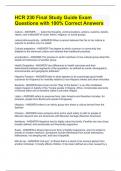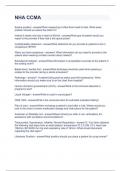HCR 230 Final Study Guide Exam Questions with 100% Correct Answers
Culture - ANSWER-___ is/are the thoughts, communications, actions, customs, beliefs, values, and institutions of racial, ethnic, religious, or social groups.
cultural ethnocentricity - ANSWER-When a person believes that his or her culture is superior to another one it is called:
Cultural adaptation - ANSWER-The degree to which a person or community has adapted to the dominant culture and retained their traditional practices.
acculturation - ANSWER-The process in which members of one cultural group adopt the
beliefs and behaviors of another group.
Health Disparities - ANSWER-"are differences in health outcomes and their determinants between segments of the population, as defined by social, demographic, environmental, and geographic attributes"
Hispanic Paradox - ANSWER-refer to what appears to be surprisingly good health outcomes for Hispanics for mortality relative to non-Hispanic whites and other minorities
Santeria - ANSWER-also known as the "Way of the Saints," is an Afro-Caribbean religion based on beliefs of the Yoruba people in Nigeria, Africa. Incorporates elements of several faiths and is therefore called a syncretic religion.
Latino - ANSWER-refers to everyone from Latin America and therefore includes, for example, people from Brazil (who speak Portuguese).
Hispanic - ANSWER-refers to an ethnic group who share a culture derived from the Spanish
Chicano - ANSWER-more exclusive term and is used solely to refer to people of Mexican descent who are Americans with Mexican heritage (Mexican American)
familismo - ANSWER-Hispanics tend to highly value the family. Families are very close, broadly defined, and emotionally and financially supportive
Susto - ANSWER-is illness that occurs from a frightful experience, and it is similar to anxiety in modern medicine. Symptoms include withdrawal from social interactions, listlessness, not sleeping well, and loss of appetite.
Mal de ojo - ANSWER-"evil eye," is illness that is a result of an envious glance from another individual. It mostly affects children. It has been defined as a hex caused by a gaze from a more powerful or stronger person looking at a weaker person (usually an infant or child but sometimes a woman).
Empacho - ANSWER-(blocked intestines) describes stomach pains and cramps that are
believed to be caused by a ball of food clinging to the stomach due to a change in eating habits, eating spoiled food, overeating, or swallowing chewing gum.
Curandero - ANSWER-is a traditional folk healer or shaman who is dedicated to curing physical and/or spiritual illnesses.
Espiritismo - ANSWER-Spanish word for "Spiritism." It is the belief in Latin America and the Caribbean that good and evil spirits can affect human life, such as one's health and luck. An opinion, doctrine, or principle (tenet) of ________ is the belief in a supreme God who is the omnipotent creator of the universe.
One of the most important predictors of health disparities is: - ANSWER-socio-economic
status
the five domains of health include - ANSWER-1. environmental exposures,
2. genetics,
3. behavior (lifestyle) choices,
4. social circumstances, and
5. medical care
The Civil Rights Act of 1964 - ANSWER-The legislation that prohibits federally funded programs from discriminating on the basis of race, color, or national origin
Title VI of the Civil Rights Act - ANSWER-prohibits federally funded programs or activities from discriminating on the basis of race, color, or national origin.
The Hill-Burton Act amendment - ANSWER-created to address discrimination against ethnic minorities in health care. Has been amended a number of times since its inception. The amendment entitled "Community Service Assurance under Title IV of the U.S. Public Health Service Act" requires facilities to provide services to persons living within the service area without discrimination based on race, national origin, color, creed, or any other reason not related to the person's need for services.
Title VI and HHS services - ANSWER-services regulations require recipients of federal financial assistance from ______ to take reasonable steps to provide meaningful access
to limited English proficiency (LEP) persons. Federal financial assistance includes grants, training, use of equipment, donations of surplus property, and other assistance.
· CLAS - ANSWER-Culturally and Linguistically Appropriate Services. Intended to advance health equity, improve quality, and help eliminate health care disparities by providing a blueprint for individuals and health and health care organizations to implement culturally and linguistically appropriate services. How many CLAS standards are there? - ANSWER-15
History of Hispanics - ANSWER-The family is considered a reliable source of health information. The family also is influential in health-seeking behaviors. They generally have a fatalistic worldview and an external locus of control, and this influences their help-seeking behaviors as well. There also is a belief that poor health is the fault of the individual and hence illness is a punishment from God. Hispanics tend to avoid conflict and criticism and prefer smooth social relations based on politeness and respect (Rhode Island Department of Health, n.d.). Overt disagreement is not considered appropriate behavior. Many Hispanics are characterized by warm, friendly, and affectionate relationships. Personal space is close and frequently shared with familymembers or close friends. Many Hispanics, particularly if they were not raised in the United States, may avoid direct eye contact with authority figures or in awkward situations. Many will nod affirmatively but not necessarily mean agreement. Silence may
mean failure to understand and embarrassment about asking or disagreeing.
Hispanic paradox - ANSWER-refer to what appears to be surprisingly good health outcomes for Hispanics for mortality relative to non-Hispanic whites and other minorities
The 10 leading causes of death among Hispanics/Latinos - ANSWER-1. Cancer
2. Heart disease
3. Unintentional injuries
4. Stroke
5. Diabetes mellitus
6. Chronic liver disease and cirrhosis
7. Chronic lower respiratory disease
8. Alzheimer's disease
9. Nephritis, nephrotic syndrome, and nephrosis
10. Influenza and pneumonia
life style rates (obesity, smoking, drinking, teenage pregnancy rate) of Hispanics - ANSWER-Hispanics have higher rates of obesity than non-Hispanic whites. Approximately 36% of Mexican American men and 45% of women 20 years old and older are obese
Hispanics have lower rates of smoking than most racial and ethnic groups. 15.8% of Hispanics smoked.
Hispanics are less likely to drink at all than are non-Hispanic whites. In fact, Hispanics have high rates of abstinence from alcohol, but Hispanics who choose to drink are more
likely to consume higher volumes of alcohol than non-Hispanic whites
The teenage birthrate among Hispanic females was higher than that of non-Hispanic white females.





